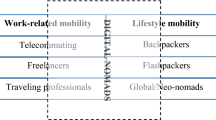Abstract
In this paper, we present an interview study of 13 recent newcomers to New York City, focusing on their early experiences of exploration and use of mobile location services and other tools for getting to know their new city. We describe their reasons and intentions behind exploratory practices using digital tools and emphasize how they make meaning out of new places in relation to technology tools as well as their previous places. Mobile location technologies make the process of finding specific places and exploring new neighborhoods a digital search task but discourage the notion of wandering and exploration. We point out missed opportunities for socio-technical systems supporting place making and place discovery and suggest that digital exploration tools should stay peripheral to the activities that people enjoy as tech-free but support a wider notion of search for salient characteristics of places.

Similar content being viewed by others
References
Brinkerhoff JM (2009) Digital Diasporas. Identity and Transnational Engagement. Cambridge University Press
Lingel J, Naaman M and Boyd D (2014) City, self, network: transnational migrants and online identity work. In Proceedings of the 17th ACM conference on Computer supported cooperative work & social computing (CSCW ‘14). ACM, New York, 1502–1510
Irina A. Shklovski and Scott D. Mainwaring (2005) Exploring technology adoption and use through the lens of residential mobility. In Proceedings of the SIGCHI Conference on Human Factors in Computing Systems (CHI ‘05). ACM, New York, NY, USA, 621–630
Nedelcu M (2012) Migrants’ new transnational habitus: rethinking migration through a cosmopolitan lens in the digital age. J Ethn Migr Stud:1339–1356
Vertovec S (2004) Cheap calls: the social glue of migrant transnationalism. Global Networks 4:219–224
Horst H and Miller D (2006) The cell phone: an anthropology of communication. Berg
Panagakos AN (2009) From Napster to MEGA: power, gender, and generation in a Greek-Canadian community. Women, Gender, and Diasporic Lives: Labor, Community, and Identity in Greek Migrations 135
Parham AA (2004) Diaspora, community and communication: Internet use in transnational Haiti. Global Networks 4(2):199–217
Bradley NA, Mark DD (2005) An experimental investigation into wayfinding directions for visually impaired people. Personal Ubiquitous Computing 9(6):395–403
Chang Y-J, 2010 T-YW (December 2010) Comparing picture and video prompting in autonomous indoor wayfinding for individuals with cognitive impairments. Personal Ubiquitous Computing 14(8):737–747
Gary LA (1999) Cognitive abilities in the service of wayfinding: a functional approach. Prof Geogr 51(4), Blackwell):555–561
Lee H (2010) Mobile social networks and urban public space. New Media Soc 12(5):763–778
Cramer H, Rost M, Lars Erik Holmquist LE (2011) Performing a check-in: emerging practices, norms and ‘conflicts’ in location-sharing using foursquare. In: In Proceedings of the 13th International Conference on Human Computer Interaction with Mobile Devices and Services ACM Press, New York, NY, pp 57–66
Evans L (2015) Being-Towards the social: mood and orientation to location-based social media, computational things and applications. In New Media & Society 17, 6, 2015, Sage, 845–860
Luca M, Zervas G (2013) Fake it till you make it: reputation, competition, and Yelp review fraud. Harvard Business School NOM Unit Working Paper 14-006(2013)
Hicks A, Comp S, Horovitz J, Hovarter M, Miki M, Jennifer LB (2012) Why people use Yelp. com: an exploration of uses and gratifications. Computers in Human Behavior 28(6):2274–2279
Simmel G (1903) The Metropolis and Mental Life. In Georg Simmel on Individuality and Social Forms. (Heritage of Sociology Series), Donald N. Levine (ed.), 1972. University of Chicago Press
Casey ES (1993) Getting back into place. Towards a Renewed Understanding of the Place-World. Indiana University Press
Harrison S and Dourish P (1996) Re-place-ing space: the roles of place and space in collaborative systems. In Proceedings of the 1996 ACM conference on Computer supported cooperative work, ACM Press, New York, 67–76
Lynch K (1960) The image of the city, vol 11. MIT press
Milgram S (1976) Psychological maps of Paris. In: Environmental psychology: people and their physical settings, 2nd edn. Holt, Rinehart and Winston, New York, pp 104–124
Bentley F, Cramer H, Hamilton W, Basapur S (2012) Drawing the city: differing perceptions of the urban environment. In Proceedings of the SIGCHI Conference on Human Factors in Computing Systems. ACM Press, New York, pp 1603–1606
Strauss A, Corbin JM (1990) Basics of qualitative research: grounded theory procedures and techniques. Sage Publications
Lingel J (2015) Information practices of urban newcomers: An analysis of habits and wandering. J Assoc Inf Sci Technol 66(6):1239–1251
Duneier M (2000) Sidewalk. Farrar, Straus and Giroux
Jacobs J (1961) The death and life of great American cities. Vintage
Diakopoulos N, De Choudhury M, 2012 MN Finding and assessing social media information sources in the context of journalism. In: Proceedings of the SIGCHI Conference on Human Factors in Computing Systems (CHI ‘12). ACM. USA, New York, NY, pp 2451–2460
Ackerman MS (2000) The intellectual challenge of CSCW: the gap between social requirements and technical feasibility. Human–Computer Interaction 15.2–3 (2000), 179–203
Putnam RD (2000) Bowling alone: the collapse and revival of American community. In: Simon & Schuster
Acknowledgments
We thank the participants for their time. Also thanks to Mor Naaman and his research group at Cornell Tech for early insights and discussion around this study.
Author information
Authors and Affiliations
Corresponding author
Additional information
Publisher’s note
Springer Nature remains neutral with regard to jurisdictional claims in published maps and institutional affiliations.
Rights and permissions
About this article
Cite this article
Barkhuus, L., Wohn, D.Y. Making the city my own: uses and practices of mobile location technologies for exploration of a new city. Pers Ubiquit Comput 23, 269–278 (2019). https://doi.org/10.1007/s00779-018-01191-z
Received:
Accepted:
Published:
Issue Date:
DOI: https://doi.org/10.1007/s00779-018-01191-z




